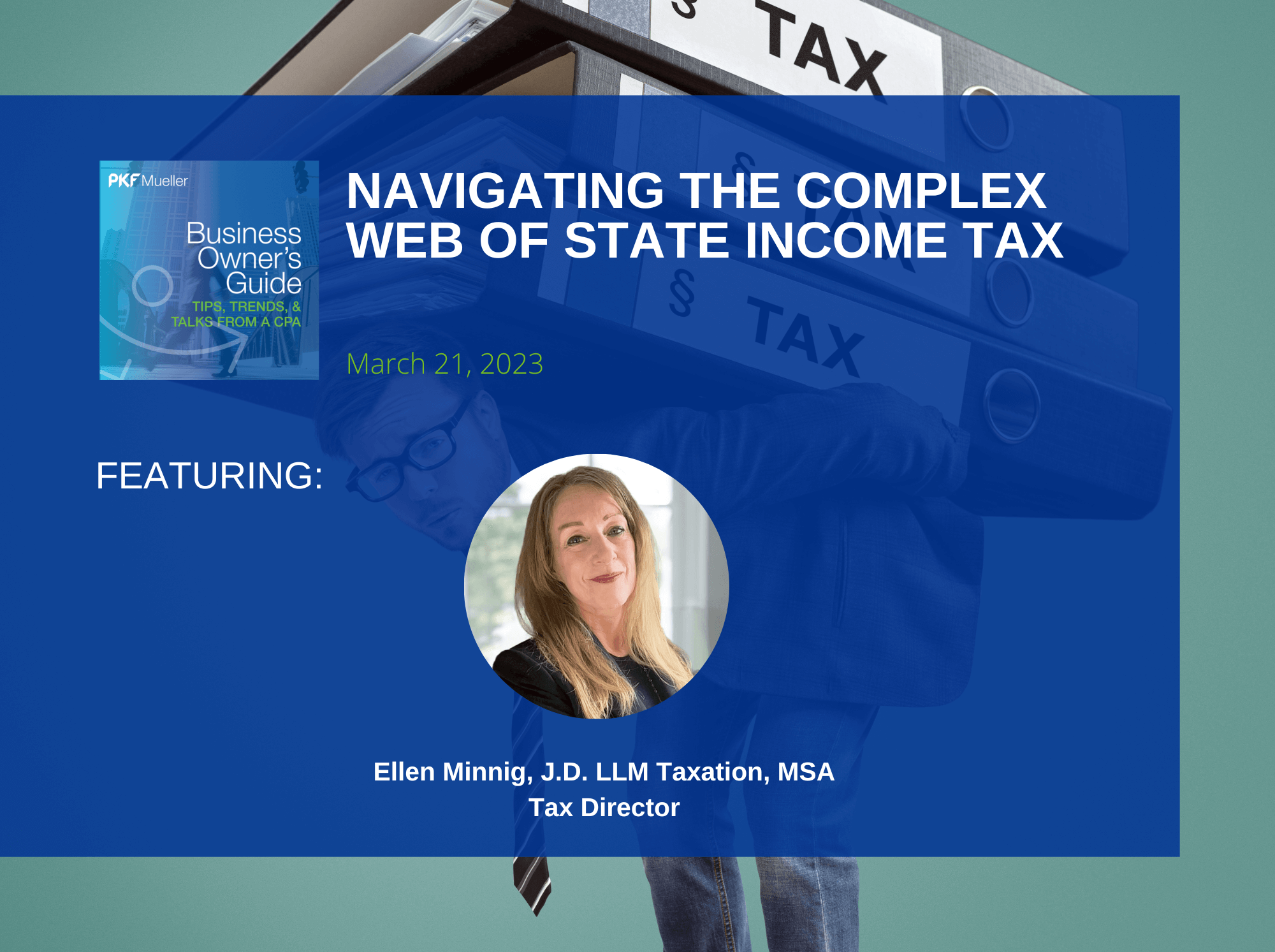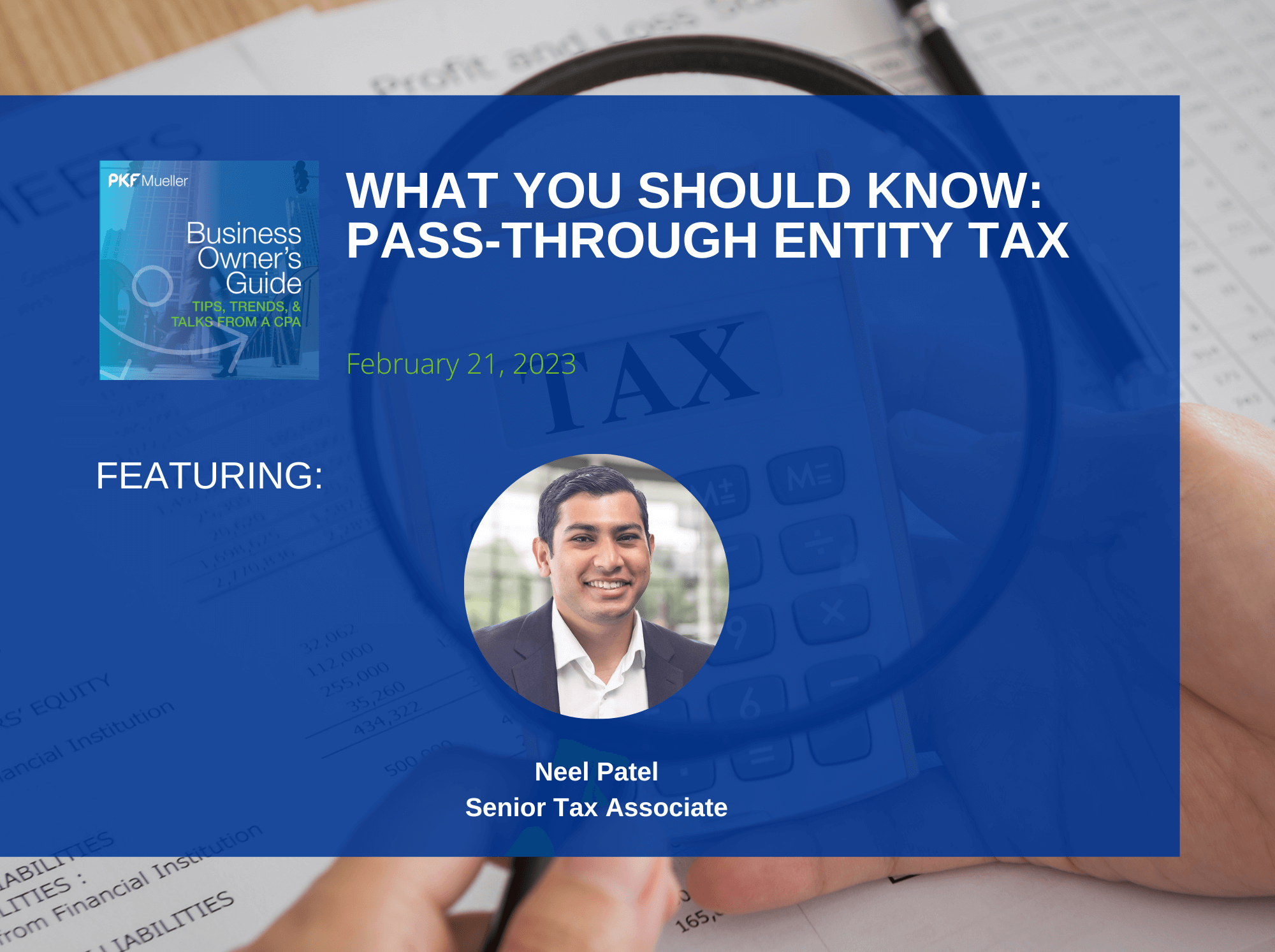Join Alex Krog, C.P.A., and James Hare III, M.A.S., C.P.A., for an in-depth interview of Employee Benefit Plan Audits (EBPA). In this episode, our experts discuss the process, accompanying fiduciary responsibilities, common errors in Benefit Plans, and the key takeaways for business owners and plan sponsors who need a Benefit Plan audit.
Listen Now:

Alex Krog, CPA
Partner
akrog@pkfmueller.com
+1 847 717 8301

James Hare III, M.A.S., CPA
Partner
jahare@pkfmueller.com
+1 847 649 8831
If you have not watched our past webinar, “Fiduciary Best Practices: Fiduciary File & Employee Benefit Audit”, you may now watch on-demand.
Episode transcript:
[00:00:00] Emily: Hi everyone, you’re listening to the PKF Mueller podcast, “Business Owner’s Guide: Tips, Trends, and Talks from a CPA.”
I’m Emily, and today we welcome directors, Alex Krog and James Hare III to discuss employee benefit plan audits. But before we begin, let’s do a quick introduction of our two guests today.
Since joining PKF Mueller in 2012, CPA, Alex Krog has been involved in providing audits, reviews, and compilations of financial statements for clients in the manufacturing, technology, and professional services industries. Additionally, he is a leader in PKF Mueller’s Employee Benefit Plan Group, providing client services and education.
James Hare III, M.A.S., and CPA, also started his career in public accounting with PKF Mueller in 2012. As a director, he works closely with clients and PKF Mueller engagement teams to complete audits, reviews, and advisory, primarily for construction and manufacturing companies James also has specialized experience in auditing 401k plans and auditing not for profit organizations.
So I just found out that my business needs an employee benefit plan audit. What do I need to know? Alex? Will you start us off with this question?
[00:01:23] Alex: You are completely screwed. You should quit your job. You should run and hide. The department of labor is coming to get you… totally kidding. You’re going to be just fine–
[00:01:33] James: I mean, maybe instead of quitting your job, you start firing a bunch of other people.
[00:01:38] Alex: No!
All right. So you found yourself, all of a sudden, you get a notice from the Department of Labor. You have over 120 eligible people who can participate in your plan and you have to get an audit. So call James, his number is (847) 649-8831. And he’ll take care of you.
[00:01:54] James: I’m free. I’ll help you out. Give me a call.
[00:01:57] Alex: Perfect. So yeah, there’s minimum requirements for, uh, receiving a benefit (plan) or needing to have a benefit plan performed on you. Everybody has to file a Form 5500, at least some form of it. So there’s a short form version. There’s a long form version. Short Form 5500 does not require audited financial statements to be attached to it.
The triggers for that are essentially once you have over 120 eligible people to participate in the plan, you have to file a long Form 5500, which needs the audit. Until you’re over the 120 mark, you can just continue on with the short form version. Now, once you cross the 120 eligible employee threshold, you have to continue to receive an audit yearly or annually, I guess, they’re the same word, until you drop down below 100 eligible people to participate in the plan. So once you go over 120, it’s like, “Oh, hey, uh, we need an audit.” You get an audit. “Hey, I’ll just let go of a couple of people. So I don’t have to pay, you know, nine, 10 grand, 15 grand for an audit.”
That’s not how it works. Uh, you have to keep getting it until you drop back below that hundred mark. So you can’t really play any games with the threshold.
[00:03:08] James: Yeah. And I think some people out there might not know… “Alright, where do I get that number from? Where, how do I know if I’m at the 120 threshold or the 100 threshold?”
Uh, and the number is reported right on, um, page one of your Form 5500, whether it’s the short form or the long form. And it’s the number based on the beginning of the year count, not the end of the year. Uh, cause sometimes we’ll get calls on October 10th saying, “Hey, we need a benefit plan audit done that’s due in five days.”
And there’s really no excuse for that. Cause you know, right away, as soon as you get a draft to that Form 5500, what that count is, and if you’re going to need that audit or not, and ideally you’re working with a good TPA (Third Party Administrator), uh, or you have a good advisor, that’s letting you know right away, uh, once you cross that threshold. So you can start trying to find a, uh, high quality audit firm to do that work for you.
[00:04:00] Emily: And can you talk about the fiduciary responsibilities that go along with benefit plans and all of the forms that you were just discussing?
[00:04:08] James: Yeah. So the, the fiduciary responsibility is I almost look at it as like a parent, parenting responsibilities. You’re almost responsible for every little facet of the benefit plan. Once you have those responsibilities. Um, and if you neglect it, bad things can happen.
[00:04:26] Alex: Yeah, they’re going to call the DHS on you instead of the DOL.
[00:04:31] James: Uh, yeah, you don’t want that to happen. Um, so you gotta be aware of what your responsibilities are once you’re in that fiduciary role.
And I guess even going back before that is some people don’t even know if they are a fiduciary or not. Um, So one of the ways you can figure that out is just by looking at your plan document, usually they’ll have the names of fiduciaries, trustees listed right in that document. So, you know ahead of time, um, because there’s some legal responsibilities that fall on your lap, if you have those fiduciary responsibilities.
So, uh, good to be aware of that. And when people have come and gone, you want to take a look at that every year. So, as well, to make sure you’re keeping that list updated.
[00:05:11] Alex: Yeah, it can definitely be a group of people that are named fiduciaries to the, to the plan, whether they’re name trustees, or it could just be an HR person or, you know, especially when there’s turnover at the company, it could just, it has to fall to somebody and it could be you and you would have no idea. It’s, it’s entirely possible.
So what you really want to make sure you’re doing is following all plan documents, do a at least annual review. I think a semi-annual review would be good just to do a complete, “Hey, are we doing everything that the plan doc says,” and, you know, reviewing payroll, distribution, vesting, are loans allowed, just everything like that. “Are we remitting our funds timely?”
And if you’re doing all of that, you’re probably fine. The biggest fiduciary responsibility that I think we see that people aren’t doing is doing an annual review of their investments that are in the plan. And this is generally where a lot of times people can get sued or get in trouble, uh, is not doing a review and creating like a watch list and looking at, uh, benchmarks from a, “Hey, uh, this rate of return on this investment is 5%.”
Hey, it’s 5%. That’s cool. Uh, versus, um, “Hey, it’s getting 5%. We’re going to benchmark it to other industry averages. And the average is 12 and a half percent.” And you guys still have a 5% fund in your plan. That’s potentially where somebody could get in trouble.
So it comes, it really comes down to if, uh, your employees are kept happy, you probably are in good shape. And if for some reason they don’t think that the plan is operating as an as intended that’s when they’re going to complain to somebody. And that’s when the Department of Labor, or somebody else, come in and look at the plan a little bit closer.
[00:07:00] James: Yeah. And some of the best practices we see there, uh, hiring an investment advisor, uh, having them come out once a year, at least maybe twice a year. Um, as part of their responsibilities and what you’re paying them to do is they’ll review your investment, making sure that you’re getting decent rates of return, making sure that the expense ratios on those investments aren’t too high. Uh, they’ll make recommendations because, you know, a lot of the times the individuals that have the fiduciary responsibilities at these plans are not financial experts.
Uh, so they don’t really know what’s going on other than, “Hey, this one had had a good rate of return last year.” Um, and the other piece of that is to document that as well. A lot of people just say, well, you know, we had a phone call or we had a quick meeting, but if you don’t have minutes to document that, that those meetings took place, they, you might as well, not even have spent the time doing it.
Uh, cause if that ever gets taken to court someday, there’s no evidence of it.
[00:08:00] Emily: So that brings up a good question of common mistakes or common issues found in employee benefit plans. What do you think about that?
[00:08:08] James: Yeah, some of the common mistakes and issues we find, um, you know, kind of getting down into the details a little bit more, uh, the big items, late remittances, I think Alex mentioned that a little while ago. Um, so late remittances, you’re withholding employees’ compensation to be remitted into their 401k plan. If you don’t do that within a certain timeframe, it can be considered late by the Department of Labor. Um, you can have to pay an excise tax on that. You can have to make them whole for any lost earnings. Um, so in addition to it being a paperwork nightmare, there’s also a, uh, financial burden as well if you’re not making those payments on time.
[00:08:52] Alex: Yeah. And then the rule for that is as soon as administratively feasible. Which–
[00:08:57] James: What does that mean?
[00:08:58] Alex: Whatever you want it to mean right?
No. Right, so the, it comes down to the Department of Labor would come in and look at, “Hey, you’ve remitted this after three days.” Three days, and then all of a sudden somebody went on, like Sally went on vacation, and it was all of a sudden 10 days because she took a week off. That could be looked at as a as a late remittance, because there was nobody else to process the payroll.
Now, you could potentially fight back and say, “Well, we did it as soon as administratively feasible because Sally wasn’t in town.” That’s not a, that’s not a great excuse. So you’re always gonna want him to make sure that there’s backup processes in place for if somebody does leave on vacation and make sure that you just want to leave that good paper trail of, Hey, three days, three days, the following Monday after payrolls run on Friday every, every two weeks or whatever your payroll, uh, breakdown is.
So, that’s the most important thing is just being consistent. And, you know, if you’re 15 days every time, is that great? Absolutely not. But at least you’re being consistent in your, uh, remittances that you’re doing, and that’s probably looked more favorably than, uh, having the, the couple a year that kind of get away from you.
[00:10:15] James: Yeah. Most the plans we see from the audit side, once we do this testing, is it, I would say anywhere between, uh, same day or five days on average between once the pay dates happen and they remit the funds into the plan.
Um, I even have a couple of clients where they remit the funds into the plan a day or two before their pay date. Uh, so kudos to them. Uh, but yeah, as Alex said, you know, 15 days isn’t ideal, you know, you should be able to get it done sooner than that, but if you’re consistent with the 15 days, then you should be fine.
[00:10:48] Alex: Yeah, and for smaller plans, there is a safe harbor of, I believe, five days that, um, kind of give you a window. So we’re the sooner, as soon as administratively feasible is generally for large plans, which is over the 120 that I have to file the long Form 5500, and we’d be auditing.
If you listening to this, and you, you know, have 50 people at your company, this is, you know, you don’t require an audit, first of all, congratulations. But second of all, you need, uh, you know, you have a five day window to get that done. So you should be in good shape.
[00:11:19] Emily: What is the process for a business owner? If they’ve just found out that they need an audit, they contact you and then what.
[00:11:28] James: Yeah. So you contact um, We will have a planning call with you to kind of give you an overview of what a benefit plan audit is. Um, we’ll set up a request list so that we can get certain information from you to kind of figure out exactly what we need to test. So we’ll want to get an example. We’ll want to get the plan document so that we can get an understanding of what your plan is, what the deferral requirements are, the eligibility requirements, distribution, uh, information. Then we’ll try to get a census, which should be a listing of all of your employees, their hire date, um, their you know compensation, various information like that.
Um, once we get that information, that’s when we go through, we make our sample selections. We’ll send those over to you, the client. You’ll start gathering what we request, which is going to be I-9 forms, um, termination letters when applicable, uh, copies of canceled checks for distributions. Um, I’m trying to think of anything else there.
[00:12:30] Alex: Yeah. I think that that would cover it substantially. And you know, a lot of this information is not being retained at clients, right? I-9s are, but a lot of times those requests for canceled checks, distribution, loan, rollover requests, are generally housed in the third party administrator of the plan. So the Fidelitys of the world, the Hancocks, the ADPs.
Um, so it’s okay if you’re listening to this and you’re like, “I don’t have any of that information.” It’s fine. Somebody else does. Um, or if you’re using a third, um, like a true TPA, uh, as well as like a record keeper, then they’re going to have the, information to to provide to us. So as long as you are maintaining payroll records, maintaining I-9s , uh, we’ll hopefully be able to take care of the rest, uh, with your third parties.
[00:13:20] Emily: If you could give me maybe three key takeaways for the plan sponsor, what would those be?
[00:13:26] Alex: The first one is it’s going to be okay.
You know, the, the reason why we’re performing an audit or the Department of Labor wants us to come in and do something, uh, and, and look at your records is because they want you to stay in compliance.
So if we’re finding stuff that isn’t being done properly, it’s totally cool. It’s not like we go to the Department of Labor or any other, uh, third-party body that could get you in trouble. We’re really there to help you get in compliance and stay in compliance. So we understand that the first year it’s going to be a little messy and that’s cool. We’re going to make sure that any corrections get made timely and we kind of get you on the right path going forward. So that’s the first one for me is it’s going to be okay.
[00:14:11] James: Yeah. I think number two is clear communication. Um, you know, as you’re working through the audit, it’s going to be okay. Um, so when we throw something at you that you’re not familiar with pick up the phone, give us a call, shoot us an email. Uh, we can have a conversation, we’ll talk through it. It’s probably not as bad as you think it is. Um, so just having that open line of communication, making sure everybody’s on the same page…
One of the biggest issues we run into is, uh, the deadline. So the initial filing deadline is July 31. Uh 10% of our clients are probably have their audits done by July 31st. Uh, So we would love to bump more up to that 7/31 deadline. But once you file an extension, the extended deadline is October 15th and we have a lot that run into that date.
Um, so we prefer to avoid that in one way we can avoid that is staying in communication with each other, uh, trying to get the information we need way in advance so we can avoid any pressure, um, on you guys, on your, the company filing your Form 5500, and ourselves.
[00:15:22] Alex: Yeah, and just for clarification, when James is talking about deadlines, the year end that he was talking about would be December 31st. So it’s seven months after whenever your deadline is. So if you’re a 6/30 year end, uh, that makes it, uh, let’s see your January 31st, and then you have a two, two and a half month extension, uh, which kicks it into, uh, I dunno, April. So, it’s seven months after year end, and then you can extend it for two and a half months regardless of when your year end is.
Uh, and I would just kind of add that the last takeaway is that, um, you know, this is an employee benefit. I know that kind of sounds weird, but you want to make sure that you’re able to attract and retain your, uh, your employees, because that’s the most important part, and this is potentially significant factor in that.
So it is really important to make sure that you are staying in compliance, that your employees are receiving the benefits they’re entitled to, uh, to make sure that you’re retaining them and keeping them happy so that you can run your business accordingly.
[00:16:28] Emily: Going off of that then have you seen, COVID-19 make an impact on some of the businesses, changing or making updates to their benefit plans?
[00:16:37] James: I mean, the specifics of the plan itself, we’re not seeing a lot of changes other than, um, you know, minor changes to be in compliance with the CARES Act. Um, you know, otherwise from an audit perspective, the change we’re seeing is that clients love not having us in their office.
[00:16:53] Alex: Nobody likes auditors.
[00:16:56] James: Um, and the benefit plans have been really easy to kind of merge to be in 100% remote cause we can send and receive everything electronically. So that’s the biggest change I’ve seen.
[00:17:06] Alex: Yep.
[00:17:07] Emily: Makes sense.
Great. Well, I think that was a really good overview from you both. Thank you so much for your time today to explain employee benefit plan audits, the process, common mistakes and key takeaways. If any of our listeners have any questions or would like to learn more, will you please share how they might be able to reach you?
[00:17:26] Alex: Yes, akrog@pkfmueller.com is my email address. My phone number that you can reach me at is (847) 717-8301.
[00:17:37] James: And you can reach me at jahare@pkfmueller.com and you can give me a call at (847) 649-8831.
[00:17:48] Emily: And thank you to our listeners. Don’t forget to visit us at pkfmueller.com to learn more about all of our firm’s services. You can also follow us on social media for more updates, insights, and upcoming events.



